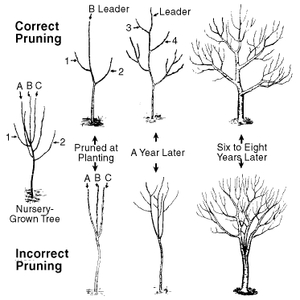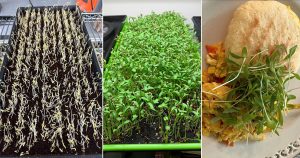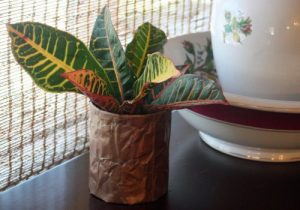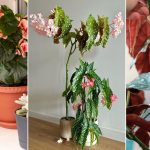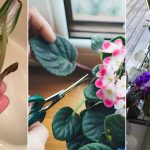I recently planted a Fuji apple tree, and in the process, had to research a bunch of things about apples. I came across a lot of information and tips related to growing apples in containers and thought I would pass along what I’ve learned. So a post about apples trees is highly appropriate!
This post is quite long, and you may not need all of the info right now, so it might be a good idea to bookmark it and come back to it as needed.
Suitably Small Varieties for Container Gardening
Don’t trust the fact that a label says “dwarf.” There is no standard definition for that term, and it is often given to trees that are not suitable for container growing. The rootstock that the tree is grafted onto determines how tall the tree will be. There is a reliable system in place for rootstock that can be trusted. You want a tree that is grafted onto P-22, M-27, M-9, or M-26 rootstock.The tag on the tree should show this info, or if you’re purchasing the tree online or through a catalog, they should list it.
One Tree or Two?
I first considered growing apples when I came across something that mentioned that some apples are self-fertile, meaning they don’t need a nearby apple to cross-pollinate with. Up until then, I thought all apples needed a buddy. As it turns out, some varieties of apples will produce fruit without another apple nearby. However, it is almost always preferable to have at least two apples as the fruit harvest that they produce will be better. I’m probably going to get another tree for that reason, where I’ll find room is another story.
If you are going to plant two apples, be sure you are planting varieties that will bloom around the same time. Otherwise, the apples will not be able to pollinate one another. The tag will often indicate which other varieties make good cross-pollinators.
Chill Hours
All fruit trees need a certain minimum amount of time where the temperature is under a certain mark. This amount is called “chill hours.” In the case of apples, the magic temperature is below 45 degrees Fahrenheit. Many apple varieties need as much as 1800 hours a year. That amount is easy to reach if you live in Chicago, but if you live in Southern California or other areas with mild climates, you’ll need to find a variety that can get by with much fewer chill hours. You can check with your extension office to find out how many chill hours your area gets.
Generally, nurseries will only carry the varieties that will do well in the area, but if you are interested in ordering an apple tree from a catalog or online, you’ll need to know the types of apples you can grow. Here are some apple varieties that will produce fruit with only a fraction of the normal amount of chill hours:
- Fuji (300-600 chill hours)
- Winter Banana (300-600)
- Hudson’s Gold Gem (300-600)
- Yellow Bellflower (400)
- Pink Lady (400)
- Anna (150-250)
- Ein Shemer (150-250)
- Beverly Hills (150-250)
- Dorsett Golden (100)
- Pettingill (100)
NOTE: Most apple trees are hardy to -25 degrees Fahrenheit, so there are very few places with “too many” chill hours. If you do live in one of those areas, move your apple tree to the garage or other cold but not too cold place. Remember that your tree needs below 45 degree temperatures for a certain period of time.
However, the roots need to stay above 15 degrees. This isn’t a problem for in-ground apples as the ground is often much warmer than the air. But the dirt in containers is closer to the temperature of the air, and you’ll need to insulate your pot or move it to a more sheltered location if your area is expecting temperatures below 15.
Getting Your Apple in the Pot
You can plant your apple any time of year that you can find healthy trees to purchase. However, you’ll find the most variety in early spring and fall. Choose a pot that is at least 10-15 gallons in size and while you’re at it, pick up some potting soil that is coarse and fast draining. If you’re going to need to move your apple tree in the winter, you’ll also want to get one of those little wheeled trolleys that you place under the pot. Put the trolley under the pot before you put the dirt in the pot and leave it there.
If you bought a bare root tree, trim the roots so that they will fit in your pot without wrapping around the pot. If you bought a tree that is in a nursery pot, inspect the roots to see if the plant is root bound. It is it, try and loosen up the roots and disentangle them. Then trim them so that they will fit in the new pot.
Fill the bottom of the pot with dirt. Then place the tree in the pot so that the graft union (the bulging point near the bottom of the trunk where the tree was grafted onto its rootstock) is level with the lip of the pot. Continue to fill the pot until the dirt in two inches below the lip of the pot. You will need to stake your tree to help support it and keep it growing upright. Be sure to tie the tree to the stake loosely! You don’t want to cut into the trunk as the tree grows.
After planting the tree, you should prune back the branches by about one third (see below for more advice on this point). Then water the tree thoroughly, until water streams out of the holes in the pot.
Watering Your Apple Tree
Keeping container plants and trees properly watered is trickier than in-ground plants, because containers dry out faster than regular gardens and also can be more water-logged. It’s sort of a damned if you do, damned if you don’t situation.
If you purchased a bare root or dormant potted tree, you will not need to water it for several weeks after the initial watering. The tree is dormant and only needs the soil to be barely moist. If the dirt is too wet, you risk causing the roots to rot. If the tree has leaves on it when you purchased it, follow the instructions below.
After your tree has shown signs of coming out of dormancy, water only when the soil is dry to the touch, every 5 or so days except when the temperatures are really high. When it is hot outside, check your tree daily to see if it needs water.
Starting in September start withholding water. Only give the tree enough water enough to keep the soil very lightly moist. This will help the tree prepare for dormancy in the winter.
Pruning to Improve Fruit Production
I found this graphic from the Clemson Extension website to be very helpful.
Basically, you want a central trunk (called the ‘leader’) and three or four main branches pointing out to the sides from the main trunk. Each side branch should be about six inches up or down the trunk from the other side branches. Any dead or damaged branches should be removed, as should any branches that are pointing inwards or that crosses (or will eventually) another branch.
The goal is to give each branch the most light possible, because lots of sunshine is needed to produce flowers and fruit. When the tree doesn’t have any leaves on it, it seems as if every branch will get enough light, but remember that in a few months, your tree will be covered in leaves (hopefully!). If you need a more detailed explanation, the Clemson Extension has very detailed instructions.
The What and When of Fertilizing
Purchase a fertilizer meant for fruit trees. Whether you purchase a chemical fertilizer like Miracle Grow, a time-release fertilizer like Osmocote, or an organic fertilizer is up to you. People who use Miracle Grow often dilute it to half strength and water their trees once a week during the growing season. If you’re using an organic fertilizer, follow the package instructions.
Start slowly reducing the fertilizer when you start reducing the amount of water in September. This will also help the tree prepare for winter. Do not fertilize your tree in winter. At best, it’s useless. At worst, you might stimulate your tree to start growing during a time when such growth could hurt the tree.
Insects That Are Problems for Container Grown Apples
Unless you plan a whole orchard of container grown apples, many of the diseases that commonly plague apple orchards are not a problem for container gardeners. Just to be safe, plant chives with your apple tree, as they help prevent apple scab, the most common disease that plagues apples.
While diseases are pretty uncommon, there are some pests that you may come across. The Coddling Moth is the most common pest. It’s caterpillars worm their way into the apple and eat the core. The best way to deal with them is to buy a pheromone trap at the garden center. It will attract the moth before it can lay more eggs, thus preventing the moth from creating more caterpillars.
Two other problem bugs are mites and aphids. They won’t eat the fruit, but they will reduce the health of the tree and if left untreated, reduce the amount and quality of the fruit your tree produces. Your best bet is to spray an insecticidal soap on your tree at the first sign of either pest. Or you try purchasing a beneficial insect that eats aphids (ladybugs) and mites (predatory mites).

